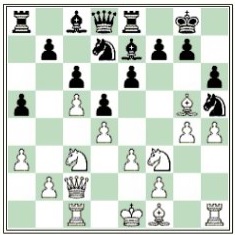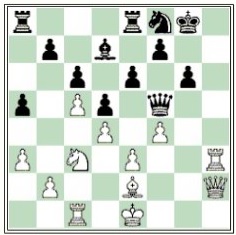“Congratulations to young Clontarf Club player B. Canton for the … brilliant and imaginative win against J.B. Steen (Ulster) in the recent Inter-Provincial match in Dublin. It is seldom one gets, much less expects, such a high standard of play in Irish chess.” [Norman Walker: Dublin Evening Herald chess column, 25th May 1955, page 7]
“[Here] is a satisfying attacking game which will be remembered with pleasure by those who have seen it before and a fresh enjoyment to all players. It … shows that the winner, Brian Canton, who played on the Irish team at Munich in 1958, can on occasion play imaginative chess of a standard unsurpassed by any Irish player.” [J.J. Walsh: Irish Times chess column, 14th September 1961, page 8]
Despite its appearance in two chess columns in different newspapers six years apart and the praise heaped on the winner and his play in the game in question, Canton’s “immortal game” has not so far found its way into the ICU database.
Brian Canton (Leinster) – J. Barnard Steen (Ulster)
Board 10, Interprovincial Match, Jury’s Hotel, Dublin, 14th May 1955
Selected annotations from Kenneth O’Riordan in the Dublin Evening Herald, 25.05.1955
[Play through the game]
1.d4 d5 2.c4 e6 3.Nc3 Nf6 4.Bg5 Be7 5.e3 0-0 6.Rc1 c6 7.Qc2 Nbd7 8.Nf3 Re8 9.a3 a5 10.c5 Nh5 11.h4 h6 12.g4
12..hxg5 13.hxg5 Nf8 14.Rxh5 g6 15.Rh3 Bxg5 16.Nxg5 Qxg5 17.f4 Qxg4 18.Qh2 Bd7 19.Be2 Qf5 20.e4
“The finest move of the game and the beginning [of] a combination which is brilliant by any standards.”
20…dxe4 21.Bg4 Qxg4 22.Rh8+ Kg7 23.Nxe4 f5 24.Qh6+ Kf7 25.Rh7+ Nxh7 26.Qxh7+ Kf8 27.Nf6
“Forcing mate. White, incidentally, has seen that Black’s checks are quite useless.”
27…Qg3+ 28.Ke2 Bc8 29.Qh8+ Ke7 30.Qxe8+ Kxf6 31.Qf8#
“As fine a mate as one could hope to get in a lifetime. White’s 20th and 21st moves were inspired.”
While looking for suitable study material ahead of the 1961-2 season, Walsh came across the game against Steen and it then found its way into his chess column. As we have seen, O’Riordan had heaped particular praise on Canton’s 20th and 21st moves, but during his analysis Walsh noticed a move order issue.
“Without detracting from Canton’s excellent winning attack it must be noted that the vital 22.Rh8+ should have been played on move 20, followed by the combination in the actual game sequence. The reason for this finesse is apparent if instead of 20…dxe4 Black tried 20…Qf6, and after 21.e5 Qg7, when although his position is undoubtedly “lost”, it is not too clear just how white can deliver the decisive blow.”
O’Riordan and Walsh were clubmates of Canton in 1955 and, like him, in the first rank of Irish chess-players for many years. However, while concurring with their overall judgment of the game, there appears to be a further significant issue with Canton’s order of moves. It may be even more important (after 20.e4 dxe4) to play 21.Rh8+ because after the move actually played in the game (21.Bg4) Black does not need to accept the Bishop sacrifice and can play instead 21…Qf6 keeping his Queen on the a1-h8 diagonal and thereby preventing the Rook check. After 22.Nxe4 Qxd4 23.Nd6 White has good attacking compensation for two sacrificed pawns, but perhaps no more than that.


